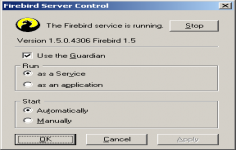 Firebird 2.1.3
Firebird 2.1.3
Firebird Project - (Open Source)
Firebird is the perfect database for developing a small program or a large enterprise information system.
Firebird is a relational database that can better manage your database and to track the behavior of your SQL programs. By implementing this tool you can refresh your data and make the correction scripts. The software runs on Windows 95/98/Millenium/2000 / XP platforms. SQL Monitor Interbase / Firebird is a freeware software.
Firebird offers good performance regardless of the size of databases, ranging from a few kilobytes to several gigabytes, without slowdowns. Among the features there can be mentioned multi-generational architecture, support for external functions (UDFs), the ACID transaction model, full support of Stored Procedures and Triggers, full internal language for Stored Procedures and Triggers (PSQL), support for External Functions (UDFs), full implementation of cursors in PSQL, incremental Backups, referential Integrity, many third-party tools, including graphical tools aministration, replication, etc, many drivers database access : Napi , dbExpress driver , ODBC, OLEDB , pilot Net native JDBC type 4 driver module, Python , PHP , Perl, etc and more.
- Title:
- Firebird 2.1.3
- File Size:
- 6.4 MB
- Requirements:
- Windows 9x / 2000 / XP / Vista / Windows7 / Windows8
- Language:
- en-us
- License:
- Open Source
- Date Added:
- 29 Sep 2009
- Publisher:
- Firebird Project
- Homepage:
- http://www.firebirdsql.org
- MD5 Checksum:
- BC21D73238A84147C90250CF61636BC7
# The default authentication method on Windows platforms is no longer mixed. It has been changed to native. For more information, see the notes on the configuration parameter Authentication.
# A fix in Firebird 2.5 that alleviates the “hogging†behaviour of the nBackup utility has been backported to this patch release. For more information, see the Improvement in V.2.1.3 note in the nBackup section of the Utilities chapter.
# By popular request, Dmitry Yemanov adds some helpful performance guidelines pertaining to the “internals†of the database monitoring system (a.k.a. “MON$â€Â). The purpose is to assist those using this facility on heavily loaded systems to employ it in ways that provide the information you want while minimising its impact on the end-user experience.
Related software
5.0/5 from 47 users

